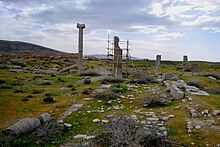
Back إصطخر Arabic اصطخر ARZ İstəxr Azerbaijani Istakhr Catalan Stachr Czech Istachr German Istajr Spanish Istakhr Basque اصطخر Persian Istakhr French
| |
 Columns at Istakhr | |
| Region | Fars province |
|---|---|
| Coordinates | 29°58′51″N 52°54′34″E / 29.98083°N 52.90944°E |
| Type | Settlement |
| History | |
| Founded | Very shortly after the decline of Persepolis (second half of the 4th century BC) |
| Periods | Classical antiquity to Late Middle Ages |
Istakhr (Middle Persian romanized: Stakhr, Persian: استخر, romanized: Estakhr) was an ancient city in Fars province, five kilometres (three miles) north of Persepolis in southwestern Iran. It flourished as the capital of the Persian Frataraka governors and Kings of Persis from the third century BC to the early 3rd century AD. It reached its apex under the Sasanian Empire (224-651 AD), and was the hometown of the Sasanian dynasty. Istakhr briefly served as the first capital of the Sasanian Empire from 224 to 226 AD and then as principal city, region, and religious centre of the Sasanian province of Pars.
During the Arab conquest of Iran, Istakhr was noted for its stiff resistance, which resulted in the death of many of its inhabitants.[1][2] Istakhr remained a stronghold of Zoroastrianism long after the conquests, and remained relatively important in the early Islamic era. It went into gradual decline after the founding of nearby Shiraz, before being destroyed and abandoned under the Buyids. Cursorily explored by Ernst Herzfeld and a team from the University of Chicago in the first half of the 20th century, much of Sasanian Istakhr remains unexcavated.
- ^ Bivar 1998, pp. 643–646.
- ^ Streck & Miles 2012.
